In our previous blog post we had discussed about Send Table via Email Salesforce Flow.In these blog post we discuss about What is Sub flow in Salesforce flow
Contents
- 1 What is Sub flow in Salesforce flow
- 2 Understanding Sub flows
- 3 Benefits of Using Sub flows
- 4 Types of Subflows
- 5 Creating a Subflow in Salesforce
- 6 Configuring Sub flows
- 7 Best Practices for Subflows
- 8 Common Use Cases for Subflows
- 9 Real-world Examples
- 10 Limitations of Subflows
- 11 Troubleshooting Subflows
- 12 Future of Subflows in Salesforce
- 13 FAQs
What is Sub flow in Salesforce flow
Understanding Sub flows
Subflows in Salesforce are essentially Flows that are called from another Flow. Think of them as mini-Flows or subprocesses that you can invoke within a primary or parent Flow. This modular approach allows for greater flexibility and reusability within your automation processes.
Benefits of Using Sub flows
Reusability
One of the primary advantages of Subflows is reusability. Once you create a Subflow, you can call it from multiple parent Flows, eliminating the need to duplicate logic and steps.
Maintenance and Scalability
By using Sub flows, you can break down complex processes into smaller, manageable pieces. This modular structure makes it easier to maintain and scale your automation solutions.
Improved Organization
Sub flows help in organizing your automation logic. Instead of having a single, massive Flow, you can create streamlined and focused Sub flows, making your automation more readable and easier to manage.
Types of Subflows
Record-triggered Flows
These Flows are triggered by changes to a record, such as creation, update, or deletion.
Schedule-triggered Flows
These are set to run at specific times or intervals, perfect for tasks like daily data updates.
Platform Event-triggered Flows
Triggered by platform events, these Flows can respond to real-time events and actions within Salesforce.
Screen Flows
Designed for user interaction, Screen Flows present information to users and collect input.
Creating a Subflow in Salesforce
Prerequisites
Before creating a Subflow, ensure you have the necessary permissions and a clear understanding of the process you want to automate.
Step-by-step Guide to Creating a Subflow
Login to Salesforce Account

Click Gear Icon Navigate to Setup
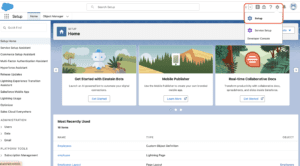
Search Quick Find box in Flows, Select Flows
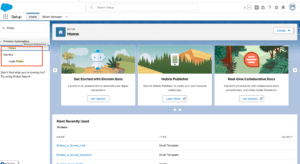
Click New Flow We want to Create
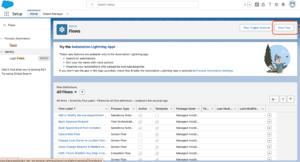
Select Screen Flow
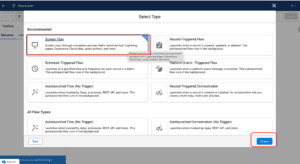
Add Elements in Click SubFlow
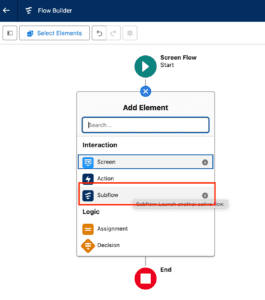
Select Existing Flow

Add details & Save Flow
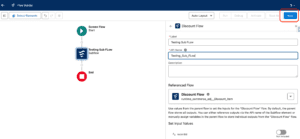
Configuring Sub flows
Setting Input and Output Variables
To ensure your Sub flow can interact correctly with parent Flows, define input and output variables. These variables allow data to pass into and out of the Subflow.
Handling Errors and Exceptions
Implement error handling within your Subflows to manage any issues that arise during execution. This can include creating fault paths and setting up notifications.
Best Practices for Subflows
Naming Conventions
Use clear and consistent naming conventions to make it easy to identify and understand your Sub flows.
Documentation
Document your Subflows thoroughly. Include descriptions and notes within the Flow itself to provide context and instructions for future users.
Testing and Debugging
Regularly test your Subflows to ensure they work as expected. Use Salesforce’s debug tools to identify and fix any issues.
Common Use Cases for Subflows
Streamlining Complex Processes
Break down intricate automation processes into simpler, reusable Subflows.
Reusing Logic Across Multiple Flows
Create Sub flows for common tasks (e.g., sending emails, updating records) and use them across different parent Flows.
Sub flows vs Other Automation Tools
Comparison with Apex
While Apex provides more control and can handle complex logic, Subflows are easier to create and maintain for less technical users.
Comparison with Process Builder
Process Builder is user-friendly but lacks the depth and flexibility of Flows and Subflows, making Flows the better choice for complex automation.
Real-world Examples
Automating Case Management
Use Sub flows to automate steps like assigning cases, sending notifications, and updating statuses based on predefined criteria.
Streamlining Lead Conversion
Implement Sub flows to handle repetitive tasks in lead conversion, such as updating related records and sending follow-up emails.
Limitations of Subflows
Performance Considerations
While Sub flows are powerful, they can impact system performance if overused or designed inefficiently.
Complexity in Design
Creating overly complex Sub flows can lead to maintenance challenges and increased chances of errors.
Troubleshooting Subflows
Common Issues and Solutions
Address common problems such as variable misconfigurations and logic errors by reviewing your Flow design and using debug tools.
Debugging Techniques
Utilize Salesforce’s debugging features to step through your Sub flows and identify issues.
Future of Subflows in Salesforce
Upcoming Features
Salesforce continually updates its platform, and new features for Flows and Subflows are always on the horizon.
Evolution of Salesforce Automation Tools
As Salesforce evolves, so do its automation tools, with increasing integration and functionality across the platform
We Want more about What is Subflow in Salesforce Flow Click Here
FAQs
Can Sub flows be triggered manually?
Yes, Sub flows can be invoked manually from a parent Flow or through custom buttons and links.
How do Sub flows impact system performance?
Sub flows can impact performance if not designed efficiently, especially if they involve complex logic or handle large volumes of data.
Are Sub flows available in all Salesforce editions?
Sub flows are available in most editions of Salesforce, but specific features may vary based on your edition and licensing.
How do Sub flows handle bulk data processing?
Sub flows can process bulk data, but it’s crucial to implement bulk-safe practices and monitor for performance impacts.
Can Sub flows interact with external systems?
Yes, Sub flows can interact with external systems using integration tools like Salesforce Connect, REST APIs, and more.
In our next blog post we will discuss about What is Assignment in Salesforce Flow

One thought on “What is Sub flow in Salesforce flow”